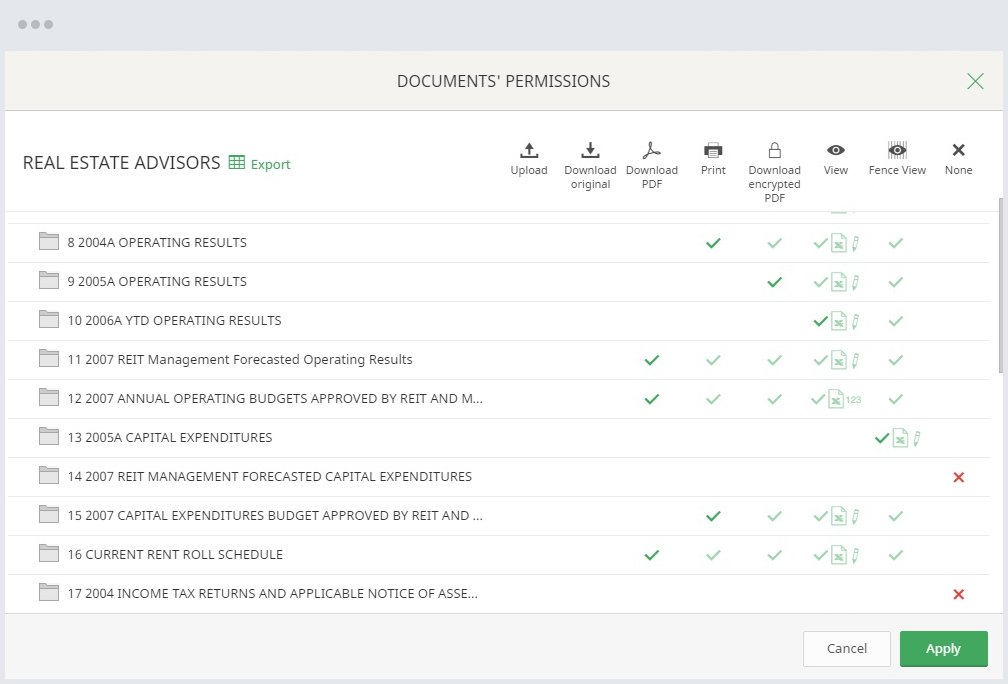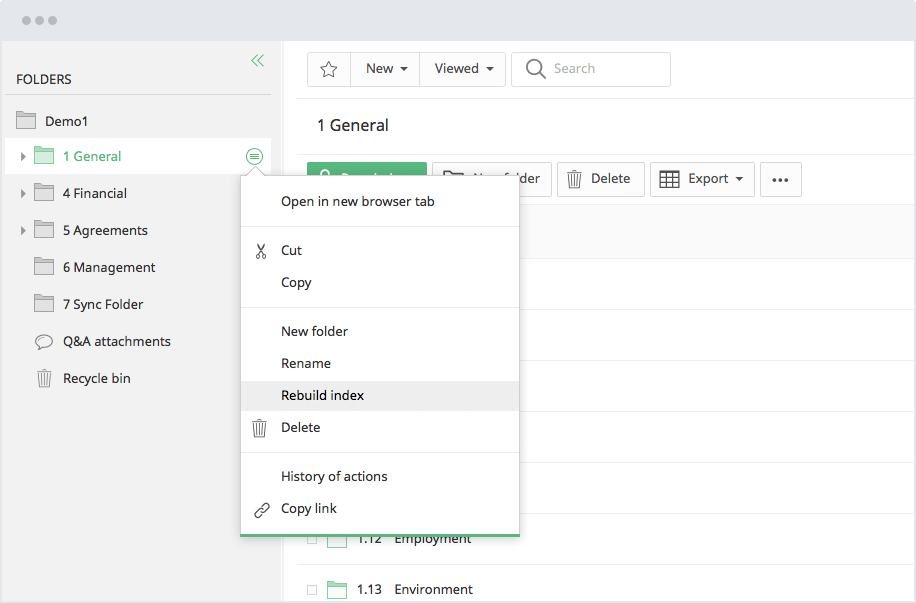Organizing a data room for a transaction is a lot like packing for a big trip. If you don’t have everything neatly arranged and easy to find, you’ll be wasting time digging through chaos. That’s exactly what this article helps you avoid.
Here we cover the importance of a well-structured data room index, share a due diligence checklist to keep things tidy, and spotlight the best providers to help you make the best choice. Learn how to organize your documents and what to include in your data room index so that everything is in its place.
What is a virtual data room index?

A data room index is a data room table of contents that lists and organizes all documents shared within a VDR platform.
A clear and logical structure of data allows users to quickly locate and review key information, reducing the risk of missed details or delays. Thus, it minimizes confusion and saves time for all parties. Besides, it improves collaboration by streamlining document navigation and ensuring everyone has access to the same organized information.
Why use indexing in a VDR?
A neat and clear data room folder structure can positively change workflows beyond data search and retrieval, providing the following benefits:
- Strengthened security. A well-organized folder structure gives you precise control over access permissions, ensuring that sensitive data is only available to authorized individuals granted access rights. With an advanced permission management system, administrators can oversee and manage access levels more easily, minimizing the risk of data breaches.

- Improved searchability. Proper categorization and tagging enable advanced search, so you can find what you need fast. This saves time during time-consuming processes like due diligence or regulatory reviews.
- Better communication. Well-organized folders keep everyone in sync throughout the deal process. Take a merger, for instance. A data room index enables legal, financial, and operations teams to access the relevant documents to make faster decisions and collaborate in real time.
- Accelerated deal speed. With quick access to organized data, decision-makers can move through reviews and approvals without delays. Specifically, they can locate key documents immediately, assess relevant information, and approve necessary actions, ensuring the deal stays on track and minimizing the risk of holdups or missed deadlines.
- Efficient automation. A data room index automates critical workflows like document categorization and updates. For example, the system automatically sorts new documents into predefined folders based on their content or metadata and tags each file for easy identification. The software also tracks document updates, such as version control or changes in access permissions, without requiring manual input.

- Simplified indexing templates. Using pre-set templates for indexing ensures consistent document categorization. These templates provide a structured approach that teams can replicate across different projects or transactions. This way, users can maintain uniformity, reduce errors, and save time.
Being a navigation tool of the platform, a data room index guides users directly to the information they need, eliminating confusion and ensuring a smooth workflow.
How to organize a proper data room index?
A well-organized index provides a clear overview of the data room’s contents and enables stakeholders to manage complex datasets with ease. Here are a few simple steps to create an effective folder structure for your data room:
1. Create a few top-level folders
Categorize the broadest sections of your data room to create top tier folders. These folders should reflect key areas relevant to your transaction or project, such as “Financials,” “Legal Documents,” or “Contracts.” Organizing all information into top tier folders gives your data room index a clear structure that helps users quickly find documents and understand the platform’s organization.
2. Create detailed subfolders
Set up specific subfolders within each category to further organize the content. For example, under the “Financials” folder, you could include “Income Statements,” “Balance Sheets,” and “Tax Returns.” This tiered data room layout ensures a logical arrangement of documents and makes it easier for stakeholders to find information.
3. Use clear and consistent document names
Ensure that all documents are named consistently, clearly, and descriptively. This helps users identify the content of each file without opening it. For instance, use standard naming patterns like “Year_Month_Type”. Proper naming rules in your data room index also reduce errors, keep things consistent, and help with efficient document searches.
4. Add users and set permissions
Add users to a data room and set appropriate permissions based on how sensitive the information is. Grant users tiered access, such as view-only, download, or edit permissions, tailored to their roles and specific needs. Thus, only authorized individuals can access confidential data.
Organizing files through structured main folders and subcategories, applying consistent naming practices, and controlling user access rights builds a streamlined, secure data environment. This approach simplifies document retrieval, supports teamwork efficiency, and ensures confidentiality of critical information.
How do virtual data rooms organize the documents?
Virtual data room index helps users categorize files, manage permissions, and get insights into document usage with the following tools:
- Control over document security. Ensures that only users with the appropriate security level can access specific documents.
- User activity tracking. Tracks who views, downloads, and uploads documents and which files are accessed the most.
- User visibility management. Allows administrators to control which groups can see each other and who can be invited to the platform.
- Data index management. Enables setting and editing a data room folder structure to maintain relevant organization.
- File renaming. Provides the ability to rename files and folders for better clarity and structure.
- Priority setting. Allows setting document request priorities as low, medium, or high.
All these data room index tools allow teams to organize, secure, and track documents with greater insight and control.
What are the common mistakes during a data room index organization?
An effective data room index brings clarity, efficiency, and security. Improper indexing may cause confusion, delay decision-making, and increase the risk of errors. So, here are some common mistakes you should avoid to optimize your data room structure:
- Using inconsistent or unclear naming conventions
Documents should have descriptive names that make sense to all users, especially when bidders need to locate specific documents quickly. A poorly named file could lead to confusion and delay, as approximately 20-30% of questions from bidders arise from difficulties in finding documents. - Neglecting user permissions
Failing to set and regularly check user permissions can cause security risks and limit the effectiveness of a data room. Therefore, VDR admins should verify that only authorized personnel can access sensitive documents. Besides, periodically auditing access logs can help identify unauthorized activity and comply with security protocols. - Ignoring multilingual index options
A multilingual index improves clarity and ensures users understand document titles in their preferred language. Ignoring this feature can create barriers for non-native speakers and hinder effective collaboration. If you deal with international stakeholders or parties that speak different languages, data room providers offering multilingual indexing like Ideals can suit you more than other services.
Your data room index determines how structured and accessible your documents are. So, the better it is organized, the more it maximizes efficiency, minimizes errors, and enables seamless collaboration.
Data room index example for due diligence
Due diligence is a time-sensitive process that requires careful organization and quick access to important information. That’s why you need a structured diligence data room index to simplify the procedure.
Here is a list of common documents typically included in the due diligence process:
- Corporate structure and legal framework
- Licenses, approvals, permits, and certifications
- Shareholder agreement
- Corporate background and history
- Articles of incorporation
- Corporate by-laws
- List of current shareholders
- List of officers and directors
- Overview of intellectual property and trademarks
- Standard client contracts
- Excerpts from the trade register
- List of top 20 customers or sales channels
- Agreements with major suppliers
- Standard employment agreements
- Resumes of key personnel
- List of lease agreements
- Guarantees issued by the company
- Financing agreements
- Overview of insurance policies
- Audited financial statements
- Current business plan
- Tax filings and accounts
The list of documents may vary depending on the specific nature of the deal, industry, and the parties involved. While these documents are generally common in the due diligence process, each transaction may require additional information on what to include in the documentation.
Data rooms with the best indexing functionality
VDR solutions vary in features, making it crucial to select the right platform. Indexing is particularly important, as most deals involve large volumes of data, and an effective data room index acts as a map of a virtual data room.
Based on user reviews and indexing functionality, we have selected the top solutions for you.
1. Ideals
Ideals offers a user-friendly and organized framework for managing documents related to M&A, the due diligence process, and other data-intensive business transactions. Key features include the following:
- Bulk renaming. Users can simultaneously rename multiple files or folders, simplifying the data room structure reorganization or standardization of naming conventions for large document sets.
- Customizable hierarchies. A data room folder structure can be tailored to suit specific project needs, such as M&A due diligence or financial audits, ensuring a personalized virtual data room index.
- Permission-based visibility. Ideals data room index ensures that each user only sees the files and folders they are authorized to access, based on admin permissions.
- Exportable index. Teams can export indexes as detailed reports for offline review, allowing stakeholders to easily view and assess the contents of the data room.
- Labeling. Users can apply labels to files and folders, organizing them by categories like document type, status, or priority.
- Multilingual index. The index structure can be translated and customized to ensure smooth collaboration across teams globally.
2. Intralinks
Intralinks streamlines document management with automatic document indexing, giving users full control over all the documents in their corporate file storage. Key features include the following:
- Automatic reindexing. In Intralinks VDRPro, the index numbers are automatically adjusted to avoid duplicates or gaps whenever items are moved, deleted, or inserted, maintaining a continuous numbering sequence.
- Flexible indexing settings. Indexing can be turned on or off for individual folders, allowing you to control which folders and documents are indexed based on your needs.
- Data room index freezing. Once a proper document structure is finalized and no further changes are needed, users can “freeze” the index order. This prevents all modifications, including adding, moving, or deleting documents. The feature works for indexed and unindexed items.
- Exportable virtual data room index list. Users can export a list of folders with their corresponding index numbers for offline review or reporting purposes.
3. Ansarada
Ansarada offers a suite of indexing features that streamline document organization and improve user experience. Key features include the following:
- Automatic numerical indexing. Ansarada assigns unique numerical indexes to files and folders, facilitating quick location and maintaining a clear data room index.
- Drag-and-drop upload. Users can upload multiple files and folders simultaneously by dragging them into the designated interface area.
- Document viewing time tracking. Ansarada data room monitors and records how long each user spends viewing individual documents, providing insights into user engagement and document usage patterns.
Compare the top solutions and make your best choice!
| Provider | Best for | Key features |
|---|---|---|
| iDeals | Customization and global collaboration | Customizable hierarchies, bulk renaming, multilingual index, and permission-based visibility |
| Intralinks | Structure control and indexing flexibility | Index freezing, automatic reindexing, flexible indexing settings, and exportable index lists |
| Ansarada | User engagement insights and quick uploads | Document viewing time tracking, drag-and-drop uploads, and automatic numerical indexing |
We recommend researching providers’ functionality and services by visiting their websites and reading user reviews on trusted platforms to make an informed decision.
Key takeaways
- A well-organized data room index ensures effective document access, improves collaboration, and minimizes errors during transactions.
- Proper indexing strengthens security, improves searchability, and accelerates deal speed.
- Using standardized naming conventions, setting user permissions, and creating clear folder hierarchies are crucial for effective data room organization.
- Leading virtual data room providers like Ideals, Intralinks, and Ansarada offer the best indexing features that streamline document management and improve user experience.


